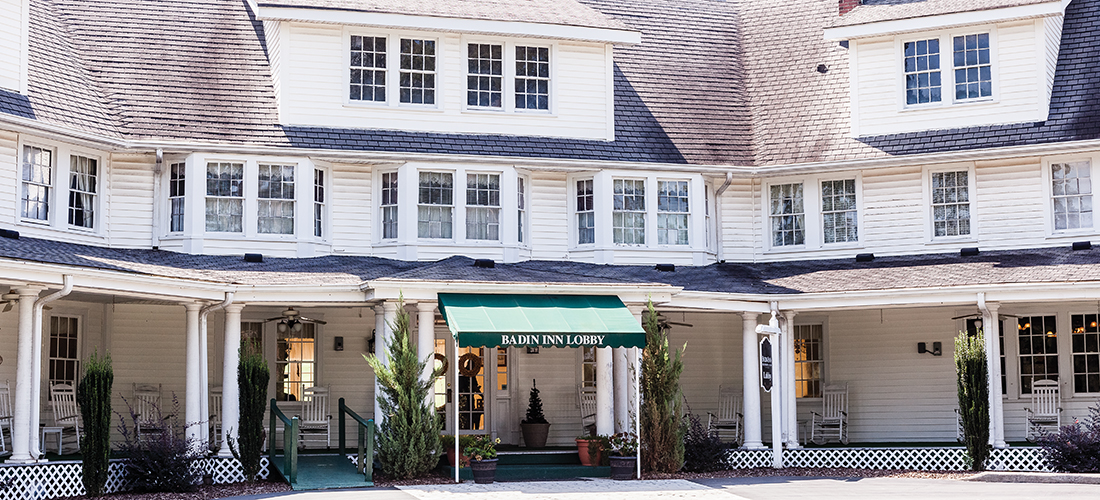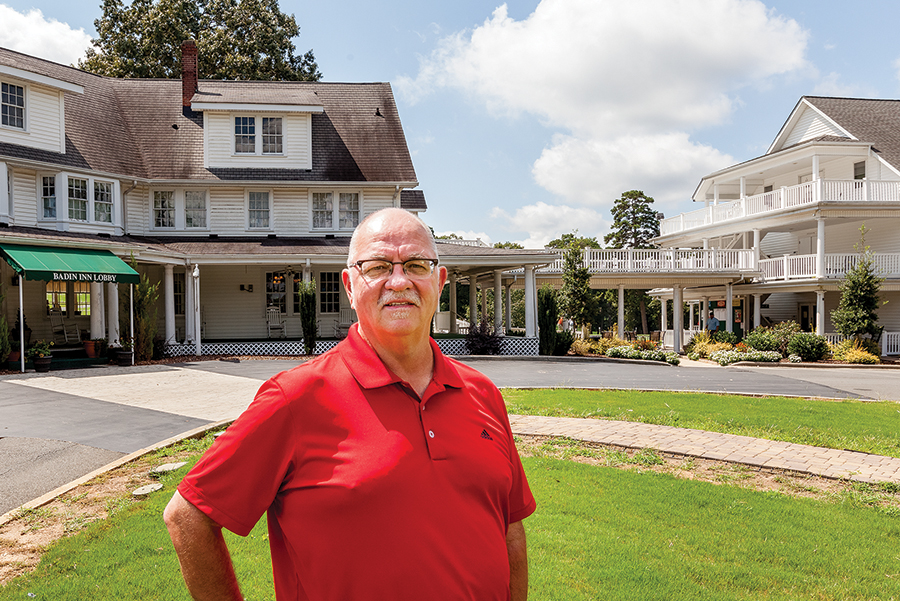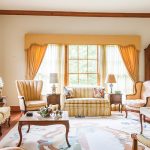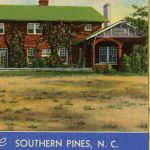
The historic town of Badin resolves to survive and thrive again
By Jim Moriarty • Photographs by John Gessner
At the center of Badin village is a confounding five-pointed starfish intersection with a right of way that seems to be ruled by nothing more than neighborliness. Where the post office now sits there was once a grand opera house. Built in 1918, it was dropped to its knees by a wrecking ball 41 years later in the days before historic preservation allowed the soul of a town to outrun its bottom line. The theater was the prime stopping point between Richmond and Atlanta for gypsy vaudevillians whose Pullman cars parked on the railroad tracks by the depot that once stood across Route 740 from a convenience store where now even the baitfish seem to have gone belly up. It was a workingman’s town then, a one-trick aluminum pony that fused the men who spent their days in Alcoa’s hot, hazardous pot rooms with imported fun. Staying sometimes as long as a week, W.C. Fields and Mae West were among the entertainers who performed there. On the same stage chorus girls left little to the imagination and Tom Mix shot up silent movie saloons, fire and brimstone preachers lit up the 650 sinners in the main auditorium, another 150 in the balconies.
Across the highway from the convenience store the hulking, desolate and empty factory buildings are covered with sorrowful rust stains as if their mascara was running. Just behind the store the little, historic village tries to climb back up the prosperity cliff it was thrown over when the company ups and leaves the company town. Badin may be more than a hundred years old, but it still has the will to live, and there is much to admire in the ambition.
A long block but a short walk up Falls Road from the starfish crossroads, pushed away from the street into the shade, an imposing red brick church gives the architectural impression of Baptists swallowing up a wandering band of orthodox Greeks sometime in the 1920s. On one side of the church is the old cemetery. Close by on the other side is the Badin Treehouse Co. It may not have a monopoly on food in Badin but it has, at the very least, cornered what passes for the gourmet market. The menu is country eclectic and the décor something of a cross between Savannah art college kitsch and your dotty old aunt’s attic. There are furs, beads, animal heads, jukeboxes, musical instruments, wild turkey feathers, and Frank Sinatra and Etta James in surround sound.

Jodi Wahab is the reluctant restaurateur, having run headlong into code issues in her original location. The plan was to have a coffee house/art gallery a few doors away in the century-old brick building with the RC Cola advertisement painted on its side where she lives with her husband, James, and her two Chihuahuas, Roxie and Allie. Or Ally. Or Alley. The actual spelling being a matter of casual indifference. Wahab got the building in an old-fashioned swap with the artist Roger Thomas, who lived in it for 13 years. “Everybody sees the potential Badin has, especially with the lake area right there,” says Thomas, who got his Route 740 farm in the deal. “I think Badin is a charming town. It’s a very neat historical town.”
The floor inside the front door of Wahab’s Falls Road building is partially covered with a large mural made mostly out of pennies. Her copper art pieces hang on one wall. The other has an elk head and a leopard — as alive as the parrot in “Monty Python’s Flying Circus’” skit — in a cage. There’s an elegant, idle coffee bar anticipating the return of the espresso machine from down the street; an out of operation waterfall waiting for unfinished oil paintings to decorate either side; and a beach cottage room with a mural of Cape Lookout and a floor covered with river sand. “What I wanted was for you to have your cappuccino and to step into my art, just come and sit,” she says. “I’m fighting to get back here.” Wahab has the U.S. franchise for Massimo Zecchi’s art supplies from Florence, Italy, but selling out of a closed coffee shop in Badin has, well, challenges. “Right now there’s no industry, so the town is just having to survive with what we are,” she says.
The town was the invention of a French company headed by Adrien Badin that came to the Yadkin River Basin early in the 20th century to make aluminum and electricity, not necessarily in that order. World War I brought the French invasion to an abrupt end and the project was taken over by the Aluminum Company of America — Alcoa — which finished construction of the Narrows Dam in 1917, helping to create the body of water that now comprises Badin Lake and Lake Tillery. Until the building of the Hoover Dam, the Narrows was the largest overflow dam in the world and it, along with the buildings of old Badin, are listed on the National Register of Historic Places. It also happens to be downriver from one of the most significant Paleo-Indian archeological sites in the southeastern United States.
Like the opera house, Badin’s dwellings were built for the aluminum workers, started by the French and finished by Alcoa. Some were small bungalows but mostly it was condo-style apartments in four conjoined units. These quadraplexes had indoor plumbing, three bedrooms upstairs and hot water that circulated through wood-burning stoves. Because people need roofs more than they need vaudeville, the lodging has outlived the tap dancers of the opera house and a handful of other buildings that became too forlorn to justify their existence to an accountant. “They tore down more buildings and destroyed more property that had historical value to it — it just makes you sick,” says Thomas.
Artifacts from the Hardaway archeological site, a Badin timeline, a refurbished quadraplex apartment and even the 1937 Ford American LaFrance fire truck (aluminum colored, of course) are on display in the visitors center and a pair of nearby museums at the starfish intersection. They open twice a week, on Tuesdays and again on Sunday afternoons. Not that there isn’t a lot of foot traffic in Badin, but if Martha Garber sees a strange face walking by during operating hours, she’s as likely as not to snatch the person right off the sidewalk.
Anne Harwood, who taught education at Pfeiffer University, is the mayor of a town with a zombie tax base. “We are a historic town with unique architecture,” says Harwood. “We’re working to keep Badin as preserved as we can.” When the moment of the great unwinding of the inevitable lawsuits arising from the end of business as usual finally arrives, Harwood sees better times. “Alcoa’s going to be generous — not just to us — they’re going to give some land to Morrow Mountain. We will get the property around the lake. That’s huge,” she says. “Then, we have to decide, with our budget, what we can do with it. Our biggest property tax group is no longer here.”
The Badin Inn, built by the French in 1914 as dormitory-style living for staff of the subsidiary of L’Aluminium Française, and its associated golf club are integral to Badin’s hand-over-hand climb back to, if not affluence, at least survivability. Stewardship of the historic structure has fallen into the hands of general manager Mark Eberle from St. Augustine, Florida. He’s partnered this museum piece, a place that’s a little tender loving care and a few investment dollars shy of being adorable, with a nonprofit organization that tries to help kids through golf. The nonprofit is called Music, Art, Literature and Thought and it’s the parent of the faith-based Growing Kids Through Golf. Back in the ’70s Eberle traveled the mini-tours, sleeping in the back of his Dodge utility van, trying to make enough money one week to play again the next. He’s chasing a different goal now. “I started that kids’ program in 1989,” says Eberle. “We’ve always targeted that group of kids that don’t naturally have an opportunity to play golf. Our purpose was never really about creating golfers of the future. We’re just trying to help kids. It was never to create the next Tiger Woods.”

The Inn has some modern suites over the pro shop, but it’s the six rooms on the second floor of the old building with the ghostly footprints of visitors like Sam Snead that are its legacy. The hallway still has a sign that says, “Pull Switch For Air Raid Alarm.” (The aluminum factory would, after all, have been a high value target during WWII.) And, there’s an intercom in the lobby that looks like it could still dial up the ’50s. The third floor remains uninhabitable, almost a metaphor. “This is pretty much Badin,” says Eberle of the Inn and golf course. “It’s a fascinating property, it really is. This is a 100-year-old inn with classic rooms, hardwood floors, furniture to match. Same way with the golf. We spent nine months improving the course, investing in it strongly. The lake is two blocks away. The river is a quarter-mile. Morrow Mountain is right behind us. They didn’t know what they had. This isn’t a resort; it’s a small town, a homey, comfortable, relaxed atmosphere. If you’re looking for a championship golf course, you don’t want to come up here. But, if you want to play golf like it was played in 1924, you’re going to love this place.”
The most famous person from Badin now is the TV personality Star Jones, but that distinction used to be held by Johnny Palmer, the Badin Blaster, who grew up caddying on the old course. A WWII veteran who flew 32 missions over Japan as the side gunner on a B-29, Palmer quit a job as a crane operator at Alcoa to join the tour and won seven times from 1946-54. Dark-haired and olive-skinned, Snead nicknamed him ‘Stone’ because his expression never changed on the golf course. In the finals of the 1949 PGA Championship at Hermitage CC in Richmond, Virginia, Snead took a 2-up lead over Palmer into the last nine holes, bounced his tee shot on the 10th off a transfer truck that kicked it back into play, made a birdie and went on to win, 3 and 2.
After moving to Oklahoma, Palmer spent the last years of his life back in Badin, living in the family apartment in a quadraplex on Spruce Avenue. His son, Jock, lives there still and can be found most days after work at the golf course’s grill. With some prodding Jock recalls a conversation with Gene Littler and Don January on a ferry ride across the Savannah River at a senior tournament. “Your dad was one of the best chippers and putters,” Jock says they told him. “He missed the TV money. He missed the senior tour. They said, hey, never let anybody tell you your dad wasn’t great.”
A lot like Badin. PS
Jim Moriarty is a senior editor at PineStraw and can be reached at jjmpinestraw@gmail.com





